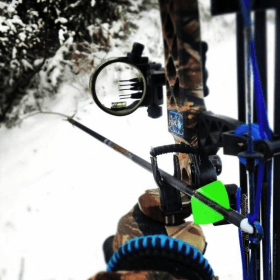- Home
- About
- Blog
- For Parents
-
Corners
- Allison’s Corner
- Amber’s Category
- Andrea’s Corner
- Ashley’s Corner
- Brandi Jo’s Corner
- Brittany’s Corner
- Brooke’s Corner
- Catrina’s Corner
- Conservation
- Desiree’s Corner
- Emily’s Corner
- Erica’s Corner
- Erin’s Corner
- Heather’s Corner
- Ivory’s Corner
- Jeana’s Corner
- Katie’s Corner
- Kelly’s Corner
- Kelsey’s Corner
- Kendra’s Corner
- Liberty’s Corner
- Lisa’s Corner
- Meagan’s Corner
- Melissa’s Corner
- Mimi’s Corner
- Morgan’s Corner
- Nicole’s Corner
- Sarah’s Corner
- Savannah’s Corner
- Shannon’s Blog
- Sharon’s Corner
- Sherri’s Corner
- Tara’s Corner
- Contact
- Guest Post

Late Season Hunting
Regardless of experience, any bowhunter knows the hottest action of the entire season occurs during the rut. Early October through November is packed with pre rut scrapes to full doe pursuit. Mature deer that were once in hiding during daylight hours can be seen traveling in open fields. No longer on their feeding and bedding patterns, bucks are more vulnerable during the rut than any other time of the season. Hunters crave the thrill of grunting and rattling a dominant buck into bow range.
Not as popular with the average bowhunter are late season hunts. Maybe it’s the fact that having a tag left to fill after the rut is hard on an ego or a sign that the season didn’t go as planned. Regardless, late season comes with frantic efforts to save the hunter’s season and fill their freezer with meat. In some cases late season hunts separate the dedicated from the ‘bread and butter’ hunters. Late season hunting is a challenge. The weather conditions alone can make a hunter question their sanity at times. Deer movement slows down and previous hunting encounters have deer on high alert. By December a large portion of mature bucks have been tagged and the survivors are much smarter than they were in early season.
Being able to operate in cold conditions and bulky layers is a necessity. The key to surviving harsh winter weather while hunting is to layer. Start with a base layer made with synthetics like Under Armour. Next, layer with something insulated and warm like fleece or flannel. The final layer will depend on the conditions faced. If rain or snow is expected the final layer should be a waterproof and/or insulated jacket. Heated garments such as the Heater Body Suit and heated boot covers are also a great option for extreme cold situations. Keep feet warm with wool socks and insulated boots from Muck or LaCrosse. To keep hands warm there are many options; waist mounted hand muffs are popular, as well as gloves with inserts for Hot Hands. Protect face and ears from cold temperatures and bitter winds with a stocking hat or full face mask. To minimize bulk wear a shooting sleeve over the forearm to avoid string to apparel contact when at full draw.
When the season winds down and rut activity is over the main priority for deer is food. Bucks spend several months participating in rut activities and need to refuel their bodies and bulk up for harsh winter conditions. Instead of hunting early season funnels and high traffic areas, concentrate on hunting food sources. Late season crops such as winter wheat, barley, and clover are great nutrients. If winter food plots are not an option seek an acorn bearing oak tree. Deer will eat black and red acorns if a better food option isn’t available.
Cold temperatures and slow deer movement can make chasing whitetails in late season a challenge. Even if a tag goes unfilled during season, experience is gained with every hunt and deer encounter. Late season is a great time to learn about behavior and find where the deer are feeding and bedding. By paying attention to detail and observing deer in late season hunters can prepare for future seasons.
Feb 09, 2014 | Category: Amber's Category, Blog | Comments: none

Leave a Reply